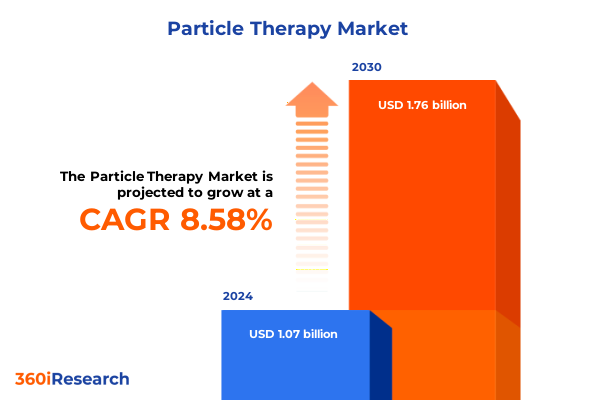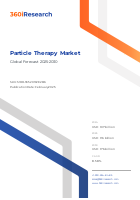The Particle Therapy Market size was estimated at USD 1.07 billion in 2024 and expected to reach USD 1.16 billion in 2025, at a CAGR 8.58% to reach USD 1.76 billion by 2030.

Introduction to Particle Therapy Market Analysis
Particle therapy has risen as a groundbreaking modality in oncological treatment, offering enhanced precision and clinical outcomes for patients across the globe. This innovative treatment exploits the unique properties of charged particles to target malignant cells with a degree of accuracy unparalleled by traditional radiation therapy. Over recent years, advancements in accelerator technology and beam delivery systems have propelled the field into a new era of clinical application and research intensity. The evolution of particle therapy is underpinned by continuous technological investments and multidisciplinary collaborations that aim to balance efficacy with minimized collateral damage. As we witness a surge in clinical trials and adoption globally, the market is positioning itself on a path that intersects innovation with increased patient-centric outcomes. In addressing both established and emerging therapy centers, the industry recognizes the need for data-driven strategies and evidence-based investment to further refine therapy protocols and infrastructure development. This analysis seeks to provide a comprehensive overview of the current landscape, the transformative shifts underway, and the segmentation insights that define market trends, ultimately preparing decision-makers to navigate an increasingly competitive and rapidly evolving field.
Transformative Shifts in the Particle Therapy Landscape
The particle therapy market is experiencing transformative shifts that redefine its operational and strategic contours. Recent technological breakthroughs, such as enhancements in beam shaping and image-guided delivery, are revolutionizing treatment protocols and improving patient safety. Regulatory frameworks are evolving in tandem with these advancements, thereby creating more enabling environments that foster innovation while ensuring compliance with rigorous safety standards. In parallel, shifts in funding patterns and the increasing participation of global stakeholders have accelerated research collaborations, which not only broaden the clinical evidence base but also streamline the integration of newer modalities into healthcare systems. The increasing emphasis on personalized medicine and targeted treatment strategies is prompting institutions to reassess their investment in multi-room versus single-room systems, seeking flexible solutions tailored to varying patient needs. Furthermore, the focus on integrating advanced analytics and real-time monitoring has fostered improved decision-making processes, enhancing operational efficiency. These systemic changes, driven by both technological innovation and strategic repositioning by key players, are paving the way for a new era where precision, accessibility, and affordability converge to shape the future of particle therapy.
Comprehensive Segmentation Insights
A detailed examination of the market segmentation reveals multiple layers of analysis that collectively inform strategic planning and investment decisions. The market is first delineated based on therapy type, wherein heavy ion therapy and proton therapy represent the cornerstone modalities. Under the component segmentation, the focus extends across critical areas including beam transport system components, cyclotrons and synchrotrons accelerators, and treatment delivery systems. Within beam transport system components, further granularity is achieved with the study of beam monitoring, bending magnets, and collimators providing additional depth into the technological framework. Furthermore, the system segmentation differentiates between multi-room systems and single-room systems, with each configuration offering distinct advantages and posing unique challenges. The application area segmentation is robust, covering conditions such as breast cancer, head and neck cancer, lung cancer, pediatric cancer, and prostate cancer, which represent diverse therapeutic demands and clinical settings. Last, the end user segmentation categorizes the market by the final consumer, including hospitals, research institutions, and specialty clinics. It is worth noting that the hospital segment is further nuanced into private and public sectors, while specialty clinics are segmented into oncology clinics and radiotherapy centers. These intertwined segmentation frameworks not only paint a multifaceted picture of the market but also help align technological capabilities with specific clinical outcomes.
- Therapy Type
- Components
- System
- Application Area
- End User
Regional Market Dynamics
An analysis by region highlights the varied maturity and potential of particle therapy markets worldwide. In the Americas, the fusion of advanced healthcare infrastructure and robust investment in R&D has accelerated the adoption of cutting-edge treatment centers. Meanwhile, the combined dynamics of Europe, the Middle East, and Africa are characterized by a mix of established clinical expertise and emerging opportunities bolstered by government initiatives and private sector involvement. The Asia-Pacific region continues to demonstrate substantial growth driven by increasing patient numbers, rising awareness of precision medicine, and accelerated modernization of healthcare facilities. These regions each contribute unique market drivers and challenges, reinforcing the need for adaptive strategies that cater to localized regulatory, economic, and technological landscapes.
- Americas
- Asia-Pacific
- Europe, Middle East & Africa
Insights on Market Leaders and Innovators
Examining the industry leaders within the particle therapy market reveals a competitive landscape propelled by innovation and strategic positioning. Prominent companies such as B dot Medical Inc. and C-Rad AB mark their presence with advanced technological offerings and robust research portfolios, providing the essential building blocks of modern particle therapy systems. Other key players including Elekta AB, Hitachi, Ltd., and Ion Beam Applications S.A have led transformative changes through continuous investments in accelerator technologies and innovative treatment delivery systems. Industry giants like Koninklijke Philips N.V. and Leybold by Atlas Copco Group further augment the market with their state-of-the-art diagnostic and imaging solutions that complement therapy systems. Mevion Medical Systems, Optivus Proton Therapy, Inc., and P-Cure Ltd are also noted for their significant contributions in making particle therapy more accessible and clinically effective. Additional innovators such as ProTom International Holding Corporation, Provision Healthcare, LLC, and PTW Freiburg GmbH have stepped forward with solutions specifically designed for precision treatment and enhanced safety protocols. SAH Global LLC, Shanghai APACTRON Particle Equipment Co., Ltd., and Shinva Medical Instrument Co., Ltd. continue to enrich the market dynamic by focusing on integration and performance improvements. Meanwhile, Siemens Healthineers AG, Stantec Inc., and Sumitomo Heavy Industries, Ltd. bring expertise in analytics and system design, while Sun Nuclear Corporation by Mirion Technologies, Toshiba Corporation, and Xstrahl Ltd. solidify their foothold with comprehensive service networks and innovative product lines that drive overall market momentum.
- B dot Medical Inc.
- C-Rad AB
- Elekta AB
- Hitachi, Ltd.
- Ion Beam Applications S.A
- Koninklijke Philips N.V.
- Leybold by Atlas Copco Group
- Mevion Medical Systems
- Optivus Proton Therapy, Inc.
- P-Cure Ltd
- ProTom International Holding Corporation
- Provision Healthcare, LLC
- PTW Freiburg GmbH
- SAH Global LLC
- Shanghai APACTRON Particle Equipment Co., Ltd.
- Shinva Medical Instrument Co., Ltd.
- Siemens Healthineers AG
- Stantec Inc.
- Sumitomo Heavy Industries, Ltd.
- Sun Nuclear Corporation by Mirion Technologies
- Toshiba Corporation
- Xstrahl Ltd.
Actionable Recommendations for Strategic Advancement
For key industry stakeholders, the path forward involves embracing strategic initiatives rooted in innovation and operational excellence. Leaders are encouraged to focus on aligning technology investments with market segmentation nuances, ensuring that the deployment of multi-room or single-room systems is tailored to specific clinical demands. It is imperative to engage with emerging digital tools that enhance real-time monitoring and decision-making, thereby optimizing patient care and operational workflows. Enhanced collaboration between research entities and clinical institutions can further accelerate the development of robust protocols, fostering both regulatory compliance and clinical safety. Moreover, the establishment of transparent communication channels with regulatory bodies and adoption of international best practices will prepare organizations to navigate shifting market dynamics. By prioritizing investments in predictive analytics and leveraging robust data insights, industry leaders can streamline capital allocation while maximizing operational efficiencies. A proactive approach that embraces technological convergence is essential for sustaining competitive advantage in an evolving landscape.
Ask ResearchAI anything
World's First Innovative Al for Market Research
Conclusion and Market Outlook
In conclusion, the particle therapy market stands at the nexus of transformative healthcare innovation and robust clinical demand. The convergence of advanced technological solutions with precise, patient-centered treatments is paving the way for significant improvements in clinical outcomes and cost efficiencies. This comprehensive analysis underscores the importance of understanding market segmentation, regional dynamics, and the strategic initiatives championed by key industry players. As the field continues to evolve, the insights provided here serve as a vital resource for stakeholders seeking to navigate both the challenges and opportunities inherent in this rapidly advancing therapeutic domain. With continued investment in R&D and the adoption of best practices, the future of particle therapy appears poised for substantial growth, with a promise of delivering enhanced care solutions to patients worldwide.
- Preface
- Research Methodology
- Executive Summary
- Market Overview
- Market Insights
- Particle Therapy Market, by Therapy Type
- Particle Therapy Market, by Components
- Particle Therapy Market, by System
- Particle Therapy Market, by Application Area
- Particle Therapy Market, by End User
- Americas Particle Therapy Market
- Asia-Pacific Particle Therapy Market
- Europe, Middle East & Africa Particle Therapy Market
- Competitive Landscape
- List of Figures [Total: 27]
- List of Tables [Total: 370 ]
Engage with Ketan Rohom for Exclusive Market Insights
For those looking to deepen their understanding of the rapidly evolving particle therapy market, there is a valuable opportunity to engage directly with expert guidance from Ketan Rohom, Associate Director, Sales & Marketing. The comprehensive market research report offers an in-depth analysis of technological advancements, segmentation nuances, regional dynamics, and competitive forces that are reshaping the industry. Decision-makers and industry strategists will benefit from detailed insights that reveal emerging trends and actionable recommendations for capitalizing on growth opportunities. Ketan stands ready to provide a personalized consultation and further elucidate how the market’s evolving landscape can be strategically harnessed to drive innovation and operational excellence. To secure access to this critical resource and position your organization at the forefront of particle therapy, consider reaching out today and take the necessary steps toward informed, strategic advancement in this dynamic field.

- How big is the Particle Therapy Market?
- What is the Particle Therapy Market growth?
- When do I get the report?
- In what format does this report get delivered to me?
- How long has 360iResearch been around?
- What if I have a question about your reports?
- Can I share this report with my team?
- Can I use your research in my presentation?




